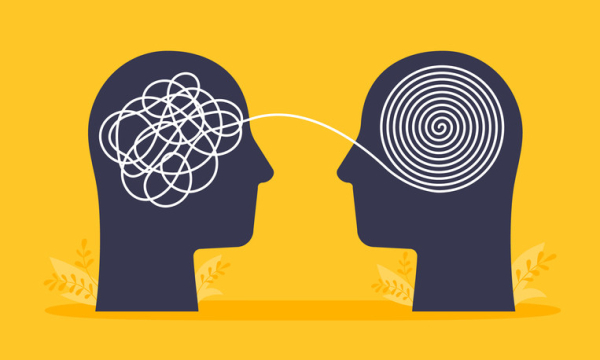
Imagine this as a morning routine that replaces your first cup of coffee:
You wake up feeling a bit foggy, so you slip on a wearable device that looks like an extra-thick headband. You turn on the power source and settle in while electrical current flows into your brain. Twenty minutes later, feeling more focused and energized, you start your busy day feeling grateful for this new technology.
If this scenario sounds strange to you, I’m with you. And yet, hype around transcranial direct current stimulation (tDCS) is growing for an expanding list of conditions such as depression, ADHD, and even Alzheimer’s disease. A recent ad for one tDCS device urges you to “elevate your performance.” But before you give this a try, read on.
What is transcranial direct current stimulation?
Brain stimulation therapies aim to activate or inhibit parts of the brain. tDCS has been around for years, but its popularity has spiked over the last decade.
tDCS devices use headgear that may look like a swim cap or headband to position electrodes against the scalp. When a power source is switched on, the electrodes deliver low levels of electrical current to the brain. A typical session lasts 20 to 30 minutes and may be repeated over days or weeks.
Three better-known brain stimulation therapies are:
- Transcranial magnetic stimulation (TMS): A device worn over the forehead stimulates specific areas of the brain by changing nearby magnetic fields. TMS is cleared by the FDA to treat depression that hasn’t responded to standard medicines, and for obsessive-compulsive disorder.
- Electroconvulsive therapy (ECT): An electric current flowing through electrodes placed at specific locations on the scalp causes a brief seizure while a patient is under anesthesia. In use since the late 1930s, ECT can be highly effective for severe depression that hasn’t responded to standard therapies. It uses higher levels of electrical current than tDCS. That’s why it requires close medical supervision and is generally administered in a hospital or specialized clinic.
- Deep brain stimulation (DBS): Electrodes surgically implanted in specific areas of the brain generate electrical pulses. DBS is used to treat conditions such as Parkinson’s disease, epilepsy, or tremors that don’t improve with medicines.
What claims are made for tDCS?
The brain normally functions by sending and receiving tiny electrical signals between nerve cells. Stimulating specific regions of the brain with low levels of electricity might improve focus or memory, mood, or even dementia, according to tDCS advocates.
Some claims say tDCS can
- improve mental clarity, focus, and memory
- increase energy and motivation
- relieve so-called brain fog following COVID-19, Lyme disease, or other conditions
- reduce depression or anxiety
- reduce cravings among smokers or people with drug addiction
- improve symptoms of ADHD or Alzheimer’s disease.
Does tDCS work?
The jury is still out. Research suggests that tDCS holds promise for certain conditions, but techniques tested through research may differ from devices sold commercially for at-home use. For example, electrodes may be positioned more precisely over an area of the brain, and how current is delivered, session length, or number of sessions may differ.
Currently, small, short-term studies show that tDCS may benefit people with:
- Depression: An analysis of 10 randomized trials found some participants were more likely to report fewer symptoms of depression, or remission of depression, after a course of tDCS treatment compared with sham treatment.
- Alzheimer’s disease: A review of seven studies found that tDCS lasting 20 to 40 minutes improved memory and other cognitive measures in people with mild to moderate Alzheimer’s disease.
- ADHD: One randomized trial of 64 adults with ADHD found improved attention after 30 minutes of tDCS daily for a month.
The FDA has not cleared tDCS for any health condition, and it is considered investigational. More research with positive results and reassuring safety data are needed before tDCS gets a thumbs-up from regulators.
That’s probably why some ads for tDCS note in fine print that it is not a medical device and is only for recreational use.
Does tDCS have downsides?
While the FDA assesses tDCS as safe for adults, there are downsides to consider. For example, treatment may cause itching, irritation, or small burns at the sites of the electrodes. Some users complain of fatigue or headache.
There are no large, long-term studies of tDCS, so overall safety is uncertain. Some experts believe at-home use raises many questions, such as how much of the brain beyond targeted areas is affected, what inconsistent approaches to tDCS use might do, and how long changes in the brain — intended or not — could last.
Very limited research has been done in children. So, the consequences for a child’s developing brain aren’t clear.
Finally, tDCS devices can be expensive (several hundred dollars or more), and generally are not covered by health insurance.
The bottom line
It’s not yet clear how tDCS should be used, or who is most likely to benefit from it. If you’re interested in pursuing tDCS, understand that there’s still a lot we don’t know.
If you’re more skeptical and risk-averse (like me), you may want to wait for more definitive research regarding its benefits and risks — and for now, stick with your morning coffee to clear your mind.
Follow me on Twitter @RobShmerling
About the Author

Robert H. Shmerling, MD, Senior Faculty Editor, Harvard Health Publishing; Editorial Advisory Board Member, Harvard Health Publishing
Dr. Robert H. Shmerling is the former clinical chief of the division of rheumatology at Beth Israel Deaconess Medical Center (BIDMC), and is a current member of the corresponding faculty in medicine at Harvard Medical School. … See Full Bio View all posts by Robert H. Shmerling, MD


 Everyone has moments when their brain suddenly goes haywire. They repeatedly fixate on the same thought, like being stuck on a hamster wheel. Or their thoughts aimlessly bounce from one random topic to the next like a pinball.
Everyone has moments when their brain suddenly goes haywire. They repeatedly fixate on the same thought, like being stuck on a hamster wheel. Or their thoughts aimlessly bounce from one random topic to the next like a pinball.




